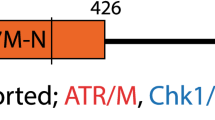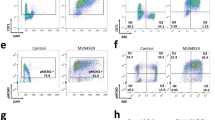Abstract
We have shown previously that chromosome VI of Saccharomyces cerevisiae contains nine origins of DNA replication that differ in initiation frequency and replicate sequentially during the S phase of the cell cycle1,2. Here we show that there are links between activation of these multiple origins and regulation of S-phase progression. We study the effects of a DNA-damaging agent, methyl methane sulphonate (MMS), and of mutations in checkpoint genes such as rad53 (ref. 3) on the activity of origins, measured by two-dimensional gel analysis, and on cell-cycle progression, measured by fluorescence-activated cell sorting. We find that when MMS slows down S-phase progression it also selectively blocks initiation from late origins. A rad53 mutation enhances late and/or inefficient origins and releases the initiation block by MMS. Mutation of rad53 also results in a late origin becoming early replicating. We conclude that rad53 regulates the timing of initiation of replication from late origins during normal cell growth and blocks initiation from late origins in MMS-treated cells. rad53 is, therefore, involved in the cell's surveillance of S-phase progression4,5. We also find that orc2, which encodes subunit 2 of the origin-recognition complex6,7, is involved in suppression of late origins.
This is a preview of subscription content, access via your institution
Access options
Subscribe to this journal
Receive 51 print issues and online access
$199.00 per year
only $3.90 per issue
Buy this article
- Purchase on Springer Link
- Instant access to full article PDF
Prices may be subject to local taxes which are calculated during checkout





Similar content being viewed by others
References
Friedman, K. L., Brewer, B. J. & Fangman, W. L. Replication profile of Saccharomyces cerevisiae chromosome VI. Genes Cells 2, 667–678 (1997).
Yamashita, M. et al . The efficiency and timing of initiation of replication of multiple replicons of Saccharomyces cerevisiae chromosome VI. Genes Cells 2, 655–665 (1997).
Paulovich, A. G. & Hartwell, L. H. Acheckpoint regulates the rate of progression through S phase in S. cerevisiae in response to DNA damage. Cell 82, 841–847 (1995).
Elledge, S. J. Cell cycle checkpoints: preventing an identity crisis. Science 274, 1664–1672 (1996).
Nasmyth, K. Viewpoint: putting the cell cycle in order. Science 274, 1643–1645 (1996).
Foss, M., McNally, F. J., Laurenson, P. & Rine, J. Origin recognition complexes (ORC) in transcriptional silencing and DNA replication in S. cerevisiae. Science 262, 1838–1844 (1993).
Bell, S. P., Kobayashi, R. & Stillman, B. Yeast origin recognition complex functions in transcription silencing and DNA replication. Science 262, 1844–1849 (1993).
Paulovich, A. G., Margulies, R. U., Garvik, B. M. & Hartwell, L. H. RAD9, RAD17, and RAD24 are required for S phase regulation in Saccharomyces cerevisiae in response to DNA damage. Genetics 145, 45–62 (1997).
Ferguson, B. M., Brewer, B. J., Reynolds, A. E. & Fangman, W. L. Ayeast origin of replication is activated late in S phase. Cell 65, 507–515 (1991).
Larner, J. M., Lee, H. & Hamlin, J. L. Radiation effects on DNA synthesis in a defined chromosomal replicon. Mol. Cell. Biol. 14, 1901–1908 (1994).
Lee, H., Laner, J. M. & Hamlin, J. L. Ap53-independent damage-sensing mechanism that functions as a checkpoint at the G1/S transition in Chinese hamster ovary cells. Proc. Natl Acad. Sci. USA 94, 526–531 (1997).
Hori, Y., Shirahige, K., Obuse, C., Tsurimoto, T. & Yoshikawa, H. Characterization of a novel CDC gene (ORC1) partly homologous to CDC6 of Saccharomyces cerevisiae. Mol. Biol. Cell 7, 409–418 (1996).
Acknowledgements
We thank J. Rine and B. Stillman for the orc2-1 mutant and its parental strain; L. H. Hartwell for the rad53-1 mutant, the mec1-1 mutant and their parental strain (7830-2-4A); and J. F. X. Diffley for critical reading of this manuscript and for unpublished results. This work was supported by grants-in-aid for Cooperative Research and for Special Projects Research from the Ministry of Education, Science and Culture, Japan, and by Special Coordination Funds for promoting Science and Technology from the Science and Technology Agency of the Japanese Government.
Author information
Authors and Affiliations
Corresponding author
Rights and permissions
About this article
Cite this article
Shirahige, K., Hori, Y., Shiraishi, K. et al. Regulation of DNA-replication origins during cell-cycle progression. Nature 395, 618–621 (1998). https://doi.org/10.1038/27007
Received:
Accepted:
Issue Date:
DOI: https://doi.org/10.1038/27007
This article is cited by
-
Unscheduled DNA replication in G1 causes genome instability and damage signatures indicative of replication collisions
Nature Communications (2022)
-
Yeast Stn1 promotes MCM to circumvent Rad53 control of the S phase checkpoint
Current Genetics (2022)
-
Effect of etoposide on grass pea DNA topoisomerase II: an in silico, in vivo, and in vitro assessments
Bulletin of the National Research Centre (2019)
-
Linking the organization of DNA replication with genome maintenance
Current Genetics (2019)
-
A low cost PS based microfluidic platform to investigate cell cycle towards developing a therapeutic strategy for cancer
Biomedical Microdevices (2018)
Comments
By submitting a comment you agree to abide by our Terms and Community Guidelines. If you find something abusive or that does not comply with our terms or guidelines please flag it as inappropriate.



